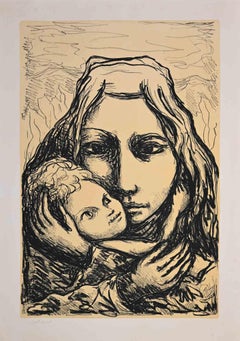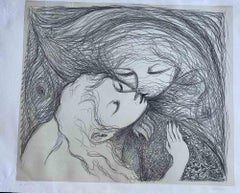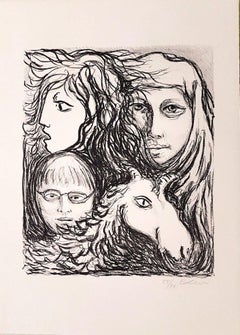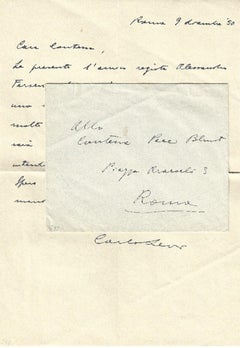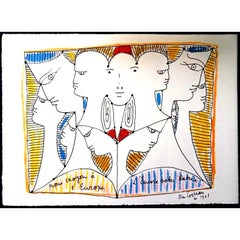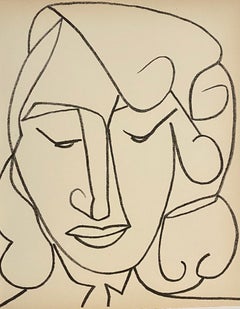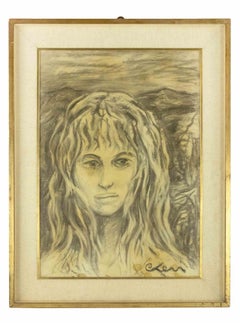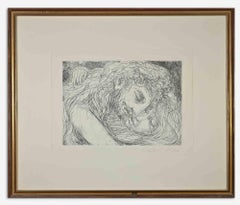Carlo Levi Art
to
2
7
2
3
5
2
1
1
5
Overall Height
to
Overall Width
to
4
3
6
5
4
4
2
2
1
7
1
1
1
7
6,909
3,240
2,514
1,217
5
1
1
1
Artist: Carlo Levi
Face - Lithograph by Carlo Levi - Mid-20th Century
By Carlo Levi
Located in Roma, IT
Face is a modern artwork realized by Carlo Levi.
Mixed colored lithograph.
Includes frame
Hand signed and numbered on the lower margin.
Edition of 52/100.
Category
Mid-20th Century Modern Carlo Levi Art
Materials
Lithograph
Mother and Child - Lithograph by Carlo Levi - Mid-20th Century
By Carlo Levi
Located in Roma, IT
Mother and Child is an original litograph realized by Carlo Levi in mid-20th century.
Good condition.
Hand signed by the artist.
Carlo Levi (29 Novembe...
Category
Mid-20th Century Modern Carlo Levi Art
Materials
Lithograph
Lovers - Etching by Carlo Levi - Mid-20th Century
By Carlo Levi
Located in Roma, IT
Lovers is an original modern artwork realized by Carlo Levi in the mid-20th Century.
Black and white etching.
Hand-signed and numbered on the lower margin...
Category
Mid-20th Century Modern Carlo Levi Art
Materials
Etching
Adam and Eve - Lithograph by Carlo Levi - Mid 20th Century
By Carlo Levi
Located in Roma, IT
Adam and Eve is an original lithograph realized by Carlo Levi in mid-20th Century.
Good condition on a red cardboard.
Hand signed by the artist.
Carlo Levi (29 November 1902 – 4 ...
Category
Mid-20th Century Contemporary Carlo Levi Art
Materials
Lithograph
Untitled - Lithograph by Carlo Levi - 1971
By Carlo Levi
Located in Roma, IT
Image dimensions: 47x40 cm.
Hand signed and numbered. Edition of 99 prints in Arabic numbers plus 25 prints in Roman numbers. In Excellent condition.
After the last edition, the ma...
Category
1970s Contemporary Carlo Levi Art
Materials
Lithograph
Autograph Letter by Carlo Levi - 1950
By Carlo Levi
Located in Roma, IT
This is an Autograph Letter Signed by Carlo Levi to the Countess A.L. Pecci Blunt.
Rome, December 9th 1950. In Italian. One page, single-sided. Excellent condition, perfecly readable. Including original envelope.
Carlo Levi (Tourin,1902 – Rome, 1975), the Italian painter, writer, activist, anti-fascist, best-known for his "Cristo si è fermato a Eboli" (Christ Stopped at Eboli),writes this letter to the Countess and patron of arts, A.L. Pecci Blunt to introduce the Italian playwright and director Alessandro Fersen (Łódź, 1911 - Rome, 2001). Artistic Intentions and common initiatives could arise.
The background:
In the same year of this letter, in 1950, Alessandro Fersen together with Walter Cantatore and Emanuele Luzzati...
Category
1950s Modern Carlo Levi Art
Materials
Paper, Ink
The Motherhood - Lithograph by Carlo Levi - 1970s
By Carlo Levi
Located in Roma, IT
The Motherhood is an original lithograph on paper by Carlo Levi in 1960s
Hand-signed on the lower right.
Artist's proof.
good conditions except for a lon...
Category
1960s Contemporary Carlo Levi Art
Materials
Lithograph
Related Items
Jean Cocteau - Europe's Diversity - Original Lithograph
By Jean Cocteau
Located in Collonge Bellerive, Geneve, CH
Original Lithograph by Jean Cocteau
Title: Europe's Diversity
Signed in the plate
Dimensions: 33 x 46 cm
Edition: 200
Luxury print edition from the portfolio of Sciaky
1961
Jean Coc...
Category
1960s Modern Carlo Levi Art
Materials
Lithograph
H 13 in W 18.12 in D 0.04 in
Portrait head of a woman, Original French Mourlot Modernist Lithograph 1950s
By Françoise Gilot
Located in Surfside, FL
Rare Original limited edition lithograph, printed by Mourlot in Paris, France on vélin du Marais watermarked paper. this is not signed as issued. This is from a signed and numbered ...
Category
1950s Modern Carlo Levi Art
Materials
Lithograph
Portrait Woman Original French Mourlot Modernist Lithograph 1951 Francoise Gilot
By Françoise Gilot
Located in Surfside, FL
Rare vintage limited edition Stone Lithograph printed at Mourlot in Paris. this is from a signed and numbered portfolio but the individual sheets are not hand signed and numbered.
Francois Gilot, (1921-) studied English Literature at Cambridge University, and then,
encouraged by her father, studied international law, though she
secretly also took art lessons at the same time. In 1943, during her
first exhibition in Paris, Gilot (then 21) met Pablo Picasso (who was
61) for the first time. In 1946, Gilot started a 10-year relationship
with the notorious womanizer and had two of his children,Claude and
Paloma. As a result of her relationship with Picasso, Gilot "became
both a witness and a participant in one of the last great periods of
the modern art movement in Europe. Their circle included poets,
philosophers, writers, and many of the legends of the art world, such
as Braque, Chagall, Cocteau and Matisse. In 1953, Gilot left Picasso
and the home they shared in Vallauris and moved back to Paris.
"Lithographs are printed from stones and each stone is an echo of my
artistic voice," said Gilot. "Many artists use their art as a personal
catharsis. I have never done that. I am more intellectual. Each
artistic process -- oils, lithographs, monotypes -- allows me a
different freedom and suits a different mood." While Gilot did her
first lithograph in 1950 at the Mourlot Atelier, the same studio used
by Picasso, Henri Matisse, Marc Chagall, Jean Miro and Jean Dubuffet,
it was in the 1970s that she really began to experiment with the
process.
"In the beginning I turned to lithography because I wanted to show off
my technical skills. Now I am more interested in color," said Gilot.
"I also thought that lithographs would make my works more accessible
to young collectors." While her oils are priced up to $100,000, her
lithographs begin at $2,000 and her monotypes range from $1,000 to
$2,500.
HONORS
Officier de la Legion d'Honneur, Presidence de la Republique, France
Chevalier de la Legion d'Honneur, Ministere de la Culture, France
SELECTED MUSEUM COLLECTIONS
Metropolitan Museum of Art, New York
Musee d'Art Moderne, Paris
Musee Picasso, Antibes, France
National Acadamy of Design, New York
Musee de Tel Aviv, Tel Aviv, Israel
Museum of Modern Art, New York
Bibliotheque Nationale, Paris (complete collection of original prints)
SELECTED IMPORTANT EXHIBITION CATALOGUES
2012 Françoise Gilot, Paris - Vallauris, 1943 - 1953, The Gagosian
Gallery, New York
Essays: John Richardson, Françoise Gilot, Charles Stuckey and Michael Cory
2011 Françoise Gilot, at 90, Drawings 1941 - 2010, Kunstsammlungen
Chemnitz, Germany
Essays: Françoise Gilot and Louise Tolliver Deutschman (exhibition curator)
2006 Françoise Gilot, Portraits From a Life, The Elkon Gallery Inc., New York
2003 Françoise Gilot Painting...
Category
1950s Modern Carlo Levi Art
Materials
Lithograph
Jewish Shtetl Mother-in-law Klezmer Wedding Dance Judaica Lithograph Yiddish WPA
By William Gropper
Located in Surfside, FL
Hand signed in pencil and numbered. A very small edition.
Old Lower East Side of New York or East European Shtetl. Jewish Shtetl Hasidic Klezmer Musicians. humorous Yiddish Chassidic art.
The New-York born artist William Gropper was a painter and cartoonist who, with caricature style, focused on social concerns, and was actively engaged in support of the organized labor movement throughout his career. This original color lithograph print is done in the iconic style of the artist's oeuvre.
Born to Harry and Jenny Gropper in 1897, William was raised in New York City's Lower East Side. His parents were Jewish immigrants from Romania and Ukraine, and young William grew up in relative poverty, watching his family struggle to achieve that sought-after American dream. His father, a bright and college-educated man, was unable to find employment that worthy of his intellect. His mother, meanwhile, worked as a seamstress from home. Coupled with the devastating loss of an aunt to the infamous Triangle Factory fire of 1911, significant childhood factors created the foundation that led to Gropper’s exploration of the American experience.
Early on, Gropper displayed an extraordinary, natural skill for art. By 1912, he was already studying under the instruction of George Bellows and Robert Henri at the Ferrer School in Greenwich Village. During his time at school, Gropper was also awarded a prestigious scholarship to study at the National Academy of Design. However, he refused to fit into convention and was swiftly expelled from the Academy. After his expulsion, Gropper returned home to help financially by assisting his mother and taking a shop position. However, he didn't abandon art academia and soon presented a portfolio to the New York School of Fine Art which earned him a scholarship for study.
Gropper obtained his first significant job as a cartoonist for the New York Tribune in 1917. While working as a staff cartoonist for the Tribune, he also contributed drawings to publications like Vanity Fair, New Masses, The Nation, and Freiheit. His interest in the welfare of the American worker, class inequality, and social injustice was central in his work. After publishing the graphic novel Alley Oop in 1930, Gropper's illustration career extended well into the decade. However, he was never exempt from controversy, and his 1935 Vanity Fair cartoon; prompted anger from the Japanese government.
As an involved labor organizer and Social Realist activist, Gropper continued to bring attention to his radical reputation with visits to the Soviet Union and Poland. However, his concern with European politics and U.S. social causes didn't slow down his artistic career, and by the late 1930s, he had produced significant murals for American cities like Washington D.C. His 1938 mural Construction of a Dam was commissioned for the Department of the Interior and represents the Social-Realism style that depicts experiences of the worker and everyday societal life. Measuring at a staggering 27ft by 87ft, the piece portrays muscular, robust American laborers scaling rocky hillsides, building infrastructure, and operating heavy machinery. The mural feels undeniably American with golden scenery, denim blues, and steely gray colors. Gropper fits perfectly into Social-Realism because the style exhibits an illustrative flair with strong lines and simple, bold hues.
The inspiration for Construction of a Dam sprang from his 1937 travels to the poverty-stricken Dust Bowl area. The trip was sponsored by a Guggenheim Foundation Fellowship, and his drawings of the Grand Coulee and Boulder Dams...
Category
Mid-20th Century Modern Carlo Levi Art
Materials
Lithograph
Pablo Picasso - Painter and His Model - Original Lithograph
By Pablo Picasso
Located in Collonge Bellerive, Geneve, CH
Pablo Picasso - Original Lithograph
Title: Painter and his Model
Edition of 180
From the book "Regards sur Paris" (Paris: Andre Sauret, 1962)
Unsigned, as issued
Dimensions: 39 x 30 cm
References: Mourlot 354, Bloch 1035
Pablo Picasso
Picasso is not just a man and his work. Picasso is always a legend, indeed almost a myth. In the public view he has long since been the personification of genius in modern art. Picasso is an idol, one of those rare creatures who act as crucibles in which the diverse and often chaotic phenomena of culture are focussed, who seem to body forth the artistic life of their age in one person. The same thing happens in politics, science, sport. And it happens in art.
Early life
Born in Malaga, Spain, in October of 1881, he was the first child born in the family. His father worked as an artist, and was also a professor at the school of fine arts; he also worked as a curator for the museum in Malaga. Pablo Picasso studied under his father for one year, then went to the Academy of Arts for one year, prior to moving to Paris. In 1901 he went to Paris, which he found as the ideal place to practice new styles, and experiment with a variety of art forms. It was during these initial visits, which he began his work in surrealism and cubism style, which he was the founder of, and created many distinct pieces which were influenced by these art forms.
Updates in style
During his stay in Paris, Pablo Picasso was constantly updating his style; he did work from the blue period, the rose period, African influenced style, to cubism, surrealism, and realism. Not only did he master these styles, he was a pioneer in each of these movements, and influenced the styles to follow throughout the 20th century, from the initial works he created. In addition to the styles he introduced to the art world, he also worked through the many different styles which appeared, while working in Paris. Not only did he continually improve his style, and the works he created, he is well known because of the fact that he had the ability to create in any style which was prominent during the time.
Russian ballet
In 1917, Pablo Picasso joined the Russian Ballet, which toured in Rome; during this time he met Olga Khoklova, who was a ballerina; the couple eventually wed in 1918, upon returning to Paris. The couple eventually separated in 1935; Olga came from nobility, and an upper class lifestyle, while Pablo Picasso led a bohemian lifestyle, which conflicted. Although the couple separated, they remained officially married, until Olga's death, in 1954. In addition to works he created of Olga, many of his later pieces also took a centralized focus on his two other love interests, Marie Theresa...
Category
1960s Modern Carlo Levi Art
Materials
Lithograph
H 15.36 in W 11.82 in D 0.04 in
Mon Colonel
By Auguste Chabaud
Located in London, GB
'Mon Colonel', pencil and crayon on paper, by noted French artist, Auguste Chabaud (circa 1914-1918). A delightfully simple drawing of a French Army colonel in profile along with clo...
Category
1910s Modern Carlo Levi Art
Materials
Paper, Crayon, Pencil
Time After Time.
By Ann Chernow
Located in Storrs, CT
Lithograph with watercolor. 22 3/8 x 30 5/8. Edition 56 (plus 5 artist's proofs). A bright impression printed on the full sheet of Arches paper. Signed and numbered 4/56 in pencil.
...
Category
Late 20th Century American Modern Carlo Levi Art
Materials
Watercolor, Color, Lithograph
La Capeline de Paille d'Italie (The Italian Straw Hat).
By Henri Matisse
Located in Storrs, CT
La Capeline de Paille d'Italie (The Italian Straw Hat). 1923. Lithograph. Duthuit 430. 17 3/4 x 15 3/4 (sheet 23 1/8 x 17 7/8). Trial proof, apart fr...
Category
Early 20th Century Modern Carlo Levi Art
Materials
Lithograph
H 30.5 in W 26.13 in D 1.5 in
Large George Grosz 1923 Lithograph Die Rauber German Expressionism WPA Realism
By George Grosz
Located in Surfside, FL
From The robbers. lithographs by George Grosz for the drama of the same name.
photolithography on watermarked paper. 19 X 25.5 inches (sheet size). This is not hand signed or numbe...
Category
1930s American Modern Carlo Levi Art
Materials
Lithograph
Hiding Head Original French Mourlot Modernist Lithograph, 1950s Francois Gilot
By Françoise Gilot
Located in Surfside, FL
Francois Gilot, (1921-) studied English Literature at Cambridge University, and then,
encouraged by her father, studied international law, though she
secretly also took art lessons a...
Category
1950s Modern Carlo Levi Art
Materials
Lithograph
Mushroom Cloud, Yue Minjun- Art, Lithograph, Limited Edition, Chinese
By Yue Minjun
Located in Zug, CH
Yue Minjun, Mushroom Cloud
Contemporary, 21st Century, Lithograph, Limited Edition, Chinese
Lithograph
Edition of 130
120 × 80cm (47 1/5 × 31 1/2 in)
Stamped Signature, numbered in R...
Category
Early 2000s Contemporary Carlo Levi Art
Materials
Lithograph
Boston Abstract Expressionist Hyman Bloom Original Pencil Drawing Martin Sumers
By Hyman Bloom
Located in Surfside, FL
This is a unique artwork. This is an original Hyman Bloom drawing of fellow artist and his very good friend Martin Sumers.I believe this was drawn at the “variations of a theme” at Sumers gallery in NYC. The last two photos show a poster and a card from their shows. it is not included in this listing, it is just for provenance.
Provenance: Acquired from the Sumers estate collection.
Hyman Bloom (March 29, 1913 – August 26, 2009) was a Latvian-born American painter. His work was influenced by his Jewish heritage and Eastern religions as well as by artists including Altdorfer, Grünewald, Caravaggio, Rembrandt, Blake, Bresdin, James Ensor and Chaim Soutine. He first came to prominence when his work was included in the 1942 Museum of Modern Art exhibition "Americans 1942 -- 18 Artists from 9 States". MoMA purchased 2 paintings from the exhibition and Time magazine singled him out as a "striking discovery" in their exhibition review.
His work was selected for both the 1948 and 1950 Venice Biennale exhibitions and his 1954 retrospective traveled from Boston's Institute of Contemporary Art to the Albright Gallery and the de Young Museum before closing out at The Whitney Museum of American Art in 1955. In a 1954 interview with Yale art professor Bernard Chaet, Willem de Kooning indicated that he and Jackson Pollock both considered Bloom to be “America’s first abstract expressionist”, a label that Bloom would disavow. Starting in the mid 1950s his work began to shift more towards works on paper and he exclusively focused on drawing throughout the 1960s, returning to painting in 1971. He continued both drawing and painting until his death in 2009 at the age of 9
Hyman Bloom (né Melamed) was born into an orthodox Jewish family in the tiny Jewish village of Brunavišķi in what is now Latvia, then part of the Russian Empire
At a young age Bloom planned to become a rabbi, but his family could not find a suitable teacher. In the eighth grade he received a scholarship to a program for gifted high school students at the Museum of Fine Arts. He attended the Boston High School of Commerce, which was near the museum. He also took art classes at the West End Community Center, a settlement house. The classes were taught by Harold Zimmerman, a student at the School of the Museum of Fine Arts, who also taught the young Jack Levine at another settlement house in Roxbury. When Bloom was fifteen, he and Levine began studying with a well-known Harvard art professor, Denman Ross, who rented a studio for the purpose and paid the boys a weekly stipend to enable them to continue their studies rather than take jobs to support their families.
He took Bloom and Levine on a field trip to the Museum of Modern Art in New York, where Bloom was impressed by the work of Rouault and Soutine and began experimenting with their expressive painting styles.
In the 1930s Bloom worked sporadically for the Public Works of Art Project and the Federal Art Project (WPA), He shared a studio in the South End with Levine and another artist, Betty Chase. It was during this period that he developed a lifelong interest in Eastern philosophy and music, and in Theosophy.
He first received national attention in 1942 when thirteen of his paintings were included in the Museum of Modern Art (MoMA) exhibition Americans 1942: 18 Artists from 9 States, curated by Dorothy Miller. MoMA purchased two of his paintings from that exhibition, and he was featured in Time magazine. The titles of his paintings in the exhibition reflect some of his recurring themes. Two were titled The Synagogue, another, Jew with the Torah; Bloom was actually criticized by one reviewer for including "stereotypical" Jewish images. He also had two paintings titled The Christmas Tree, and another titled The Chandelier, both subjects he returned to repeatedly. Another, Skeleton (c. 1936), was followed by a series of cadaver paintings in the forties, and The Fish (c. 1936) was one of many paintings and drawings of fish he created over the course of his career.
Bloom was associated at first with the growing Abstract Expressionist movement. Willem de Kooning and Jackson Pollock, who first saw Bloom's work at the MoMA exhibition, considered Bloom "the first Abstract Expressionist artist in America." In 1950 he was chosen, along with the likes of de Kooning, Pollock, and Arshile Gorky, to represent the United States at the Venice Biennale. That same year Elaine de Kooning wrote about Bloom in ARTnews, noting that in paintings such as The Harpies, his work approached total abstraction: "the whole impact is carried in the boiling action of the pigment". In 1951 Thomas B. Hess reproduced Bloom's Archaeological Treasure in his first book, Abstract Painting: Background and American Phase, along with works by Picasso, Pollock, and others. Both de Kooning and Hess remarked on Bloom's expressive paint handling, a key characteristic of Abstract Expressionist painting.
As abstract expressionism dominated the American art world, Bloom became disenchanted with it, calling it "emotional catharsis, with no intellectual basis." In addition, instead of moving to New York to pursue his career, he opted to stay in Boston. As a result he fell out of favor with critics and never achieved the kind of fame that Pollock and others did. He disliked self-promotion and never placed much value on critical acclaim.
Many of Bloom's paintings feature rabbis, usually holding the Torah. According to Bloom, his intentions were more artistic than religious. He began questioning his Jewish faith early in life, and painted rabbis, he claimed, because that was what he knew. Over the course of his career he produced dozens of paintings of rabbis...
Category
20th Century Modern Carlo Levi Art
Materials
Paper, Pencil
Previously Available Items
Portrait of Girl - Drawing by Carlo Levi - Mid-20th Century
By Carlo Levi
Located in Roma, IT
Portrait of Girl is an original modern artwork realized by Carlo Levi in the mid-20th Century.
Black and white charcoal drawing.
Hand signed on the lower ...
Category
Mid-20th Century Modern Carlo Levi Art
Materials
Charcoal
H 25.99 in W 33.86 in D 0.04 in
Lovers - Etching by Carlo Levi - Mid-20th Century
By Carlo Levi
Located in Roma, IT
Lovers is an original modern artwork realized by Carlo Levi in the mid-20th Century.
Black and white etching.
Hand signed and numbered on the lower margin...
Category
Mid-20th Century Modern Carlo Levi Art
Materials
Etching
H 11.42 in W 15.75 in D 0.04 in
Lovers - Original Etching by Carlo Levi - 1964
By Carlo Levi
Located in Roma, IT
Lovers is an original black and white etching realized by Carlo Levi in 1964.
Hand signed on the right margin. Numbered on the lower left.
Image dimension...
Category
1960s Contemporary Carlo Levi Art
Materials
Etching
Lovers - Original Lithograph by Carlo Levi - 1970s
By Carlo Levi
Located in Roma, IT
Lovers is an original lithograph, realized by Carlo Levi, the state of preservation of the artwork is very good, signed.
Image dimension: 38.5 x 29 cm
She...
Category
1970s Contemporary Carlo Levi Art
Materials
Lithograph
Peasants - Original Lithograph by Carlo Levi - 1970s
By Carlo Levi
Located in Roma, IT
Interesting b/w litograph, representing a couple farmers' portrait. Hand-signed and numbered with pencil on lower margin. Edition of 100 prints. In Excellent condition.
Category
1970s Contemporary Carlo Levi Art
Materials
Lithograph
H 19.69 in W 27.56 in D 0.04 in
Carlo Levi art for sale on 1stDibs.
Find a wide variety of authentic Carlo Levi art available for sale on 1stDibs. If you’re browsing the collection of art to introduce a pop of color in a neutral corner of your living room or bedroom, you can find work that includes elements of orange and other colors. You can also browse by medium to find art by Carlo Levi in lithograph, charcoal, etching and more. Much of the original work by this artist or collective was created during the 20th century and is mostly associated with the modern style. Not every interior allows for large Carlo Levi art, so small editions measuring 9 inches across are available. Customers who are interested in this artist might also find the work of Mario Logli, Antonio Recalcati, and Enrico Benaglia. Carlo Levi art prices can differ depending upon medium, time period and other attributes. On 1stDibs, the price for these items starts at $267 and tops out at $1,248, while the average work can sell for $384.

